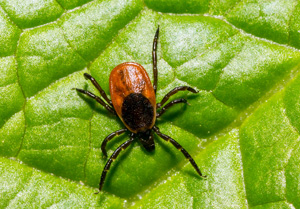by Jill Spencer, MD March 20, 2024
As spring and summer approach, unfortunately, so do insect and tick bites. Here are a few high-yield facts to watch out for over the next few months.
- Lyme disease is caused by a bacterium (Borrelia burgdorferi) transmitted to humans by the bite of a tick. Thankfully, the prevalence in the midwest is low, with higher-risk areas including the northern and northeastern United States.
 The ticks capable of transmitting Lyme disease are primarily black-legged deer ticks (Ixodes scapularis).
The ticks capable of transmitting Lyme disease are primarily black-legged deer ticks (Ixodes scapularis). - Ticks usually need to remain attached to the skin for at least 24 hours to transmit the disease.
- Prevention is key: wear protective clothing including long pants, long sleeves, socks and closed-toed shoes. Use insect repellent containing DEET or permethrin on clothing and exposed skin. Check skin thoroughly for ticks after spending time outdoors, and remove ticks before they become engorged. It is also recommended to treat and monitor your pets.
- Tick removal: use clean, fine-tipped tweezers to grasp the tick as close to the skin’s surface as possible. Pull upward with steady, even pressure, and avoid twisting or jerking. After removal, clean the bite and your hands with rubbing alcohol or soap and water.
 What to look out for: erythema migrans (EM) rash appears in 70-80% of infected persons and usually develops between day 3-30 after the tick bite. It appears as a round or oval patch that expands gradually over several days and often forms a bullseye pattern. Fever, chills, headache, fatigue, muscle and joint aches, and swollen lymph nodes may occur even without the presence of a rash.
What to look out for: erythema migrans (EM) rash appears in 70-80% of infected persons and usually develops between day 3-30 after the tick bite. It appears as a round or oval patch that expands gradually over several days and often forms a bullseye pattern. Fever, chills, headache, fatigue, muscle and joint aches, and swollen lymph nodes may occur even without the presence of a rash. - A small bump or redness at the site of a tick bite that occurs immediately and resembles a mosquito bite is normal. This should self-resolve.
Stay safe and enjoy the time outdoors as we continue to experience the beautiful weather!


